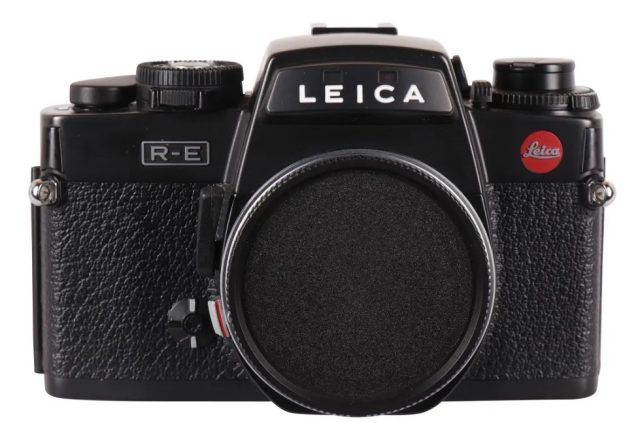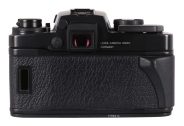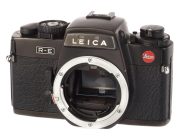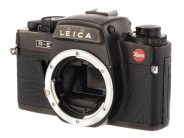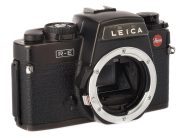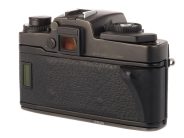Announced
Order No.
System
Leica R-E
35mm MF film SLR camera
Specification
| Format: | |
| 35mm full frame | |
Film type: | 135 cartridge-loaded film |
| Leica R [47mm] | |
| Shutter: | |
Type: | Focal-plane |
Model: | Electronically controlled |
Speeds: | 15 - 1/2000 + B |
| Exposure: | |
Exposure metering: | Through-the-lens (TTL), open-aperture |
Exposure modes: | Aperture-priority Auto |
| Manual | |
| Physical characteristics: | |
Weight: | 625g |
Dimensions: | 138.5x89.1x63.5mm |
| Accessories: | |
Body cap: | 14103 |
Manufacturer description
Electronically controlled, compact single-lens reflex camera; two modes: aperture priority with selective or full-field integral exposure metering; exposure metering memory; and manual mode with selective metering. TTL-flash exposure control with system-compatible flash units. Exposure times from 1/2000 s to 1/2 s (manual mode), or to 15 s in automatic mode. Interchangeable focusing screens. Eyepiece diopter setting from -2 to +2 diopters. Hinged camera back with connection for Data Back without cable.
From the Photo Technique International magazine (January 1991)
The Leica model range runs counter to the conventional marketing approach. The simplest Leica SLR, the all-mechanical R6, is also the most expensive - because today mechanical construction costs more than electronic systems. Below that in price is the multimode R5 with programmed automation features. Less expensive still is the latest Leica R-E - which logically belongs between the R5 and the R6.
The R-E is thus a simplified Leica R5 minus two of the latter's operating modes: it has no shutter speed-priority AE and no programmed automation. It is to the R5 what seven and five years ago the lower-cost R4s and R4s/2 were to the Leica R4. The Leica R-E looks virtually identical to the R4s/2 but features modernised facilities of the R5, such as TTL flash control and the focusing finder eyepiece.
The Leica R-E thus offers two automatic exposure control modes - aperture priority AE and TTL flash automation - plus manual operation. As before, the selector lever below the shutter speed dial switches the modes. In AE mode, the shutter speeds set by the system appear on an LED scale to the right of the finder screen. The times are shown in full steps up to 1/2000 sec; in fact, the electronically controlled time is stepless from 1/2000 sec to 15 sec. In manual mode times may be set in full steps from 1/2 to 1/2000 sec and these settings appear reflected below the finder screen.
There is an auto exposure override correction going up to +/-2 EV in one-third steps. On unlocking this correction it is conveniently adjustable for bracketing exposure sequences. This exposure correction is also linked with the film speed setting (ISO 12 to 3200).
Also retained from the Leica R5 are the two metering modes: Centre-weighted full-area readings and selective or spot readings. Both are available in aperture-priority AE model in manual mode the camera switches to selective readings. Meter modes are switched with the same selector lever as exposure control modes. The semi-silvered main mirror and the auxiliary Fresnel reflector behind it divert about 30% of the light from the lens to the silicon cell in the camera bottom.
For selective readings a condenser lens automatically moves in front of the silicon cell and concentrates the metering area on a central field corresponding to 5% of the finder area. This is a central circle of 7 mm diameter, marked on the current Leica R focusing screens.
With full-area readings the meter's lower response limit (with an f/1.4 lens) is 0.25 cd/m2. In terms of an ISO 100 film that is equivalent to +1 EV. With selective readings the lower metering limit is 1 cd/m2 or EV +3 - thanks to the concentration mentioned only 2 EV (and not 4 1/2 EV) above that for full-area readings.
For flash exposures, a further silicon cell alongside the regular one measures the light reflected from the film during the flash exposure. This cell then automatically controls the flash duration (and hence effective exposure) of an appropriate dedicated flash unit. Such dedicated flashes are units compatible with the SCA 300 system (currently made by Metz, Cullmann, Osram and Regula); these are linked to the camera via an SCA 351 adapter fitted in the R-E's hot shoe. The flash synch time is 1/100 sec. When charged ready to flash, SCA-compatible automatically set the camera to this shutter speed via the SCA-351 adapter. Automatic flash duration control operates also with the camera in manual exposure mode.
The prism finder - with silver-plated reflecting surfaces - has an adjustable eyepiece (from +2 to -2 dioptres). As with all Leica SLR Models since the R4, the focusing screen is interchangeable. Underneath the screen image LED signals indicate the exposure control and metering mode, exposure override warning, flash readyness and correct flash exposure (auto check signal).
There is nothing new on the R-E that was not already available on the Leica R5. Some innovations are overdue: for instance film speed sensing of DX-coded film cartridges.
For the time being, Leica also keeps to the idea of a separate winder and motor drive. This makes sense: A Leica SLR used to be among the heaviest and bulkiest cameras of its kind. Without a motor drive the Leica R-E (like the R5 and R6) is today one of the more compact 35 mm SLRs. But sooner or later Leica will have to make up its mind about investing in the production of an autofocusing SLR.
LENS-DB: Rather later than sooner: Leica's first interchangeable-lens autofocus SLR camera, the medium-format Leica S2, appeared only in 2008.
A point very much in favour of the Leica R-E is that it opts out of the current technical overkill trend. With just two exposure control and metering modes, operation is easy (and easy to learn) - without multi-functional selector buttons, up/down switches or LCD panels. In this sence, the R-E is almost an entry-level camera for the user apprehensive of electronic programming.
In other respects of course the system concept of the Leica SLRs (as of the rangefinder cameras) is hardly an entry level one. Leica sales figures confirm that very few Leica buyers are indeed photographic beginners.
From the editor
A simplified version of the R5 designed to attract first-time Leica buyers. The users received the same center-weighted full-area and spot-meter readings, plus through-the-lens (TTL) flash control, aperture-priority auto exposure, and manual mode, but not shutter-priority auto exposure and programmed auto-exposure modes. Other R5 features remained too: top 1/2000-sec. shutter, diopter correction, interchangeable screens. Was made in black chrome only.
Special editions (1)
- Leica R-E "OLYMPISCHE SPIELE 1992" (5000 units) - 1992
